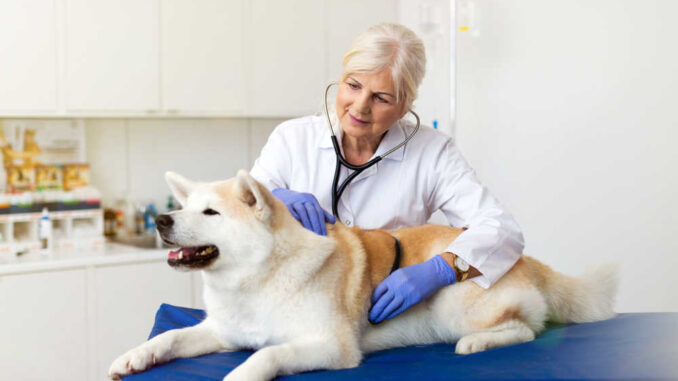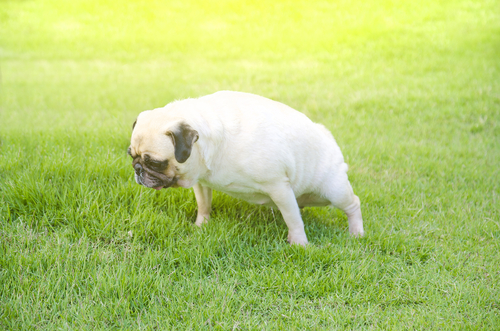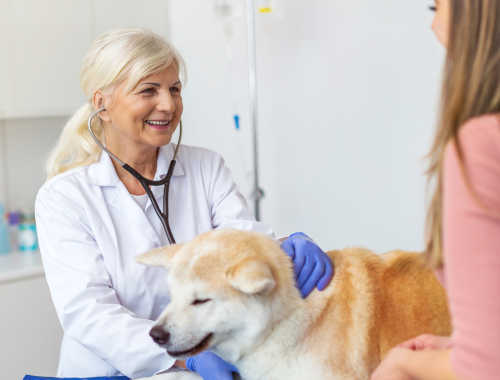
This article was updated on May 2nd, 2023
I recently received a call from a client with a two-year-old intact bitch who had a pink mass bulging from her vulva. I figured it was a vaginal prolapse. Upon getting a history and examining the dog, I was able to confirm my suspicions and advise the owner about how to handle the situation. Truly, the sight of vaginal prolapse can be disconcerting to dog owners, but it is often a manageable condition. In this article, we’ll examine common questions you may have about vaginal prolapses, and how to best help your dog.
What is vaginal prolapse in dogs?
When a dog has a vaginal prolapse, the lining of the vaginal wall swells and bulges out through the vulva. The condition usually occurs in younger unspayed females shortly before or during the heat cycle. In this case, a surge of estrogen causes swelling and protrusion. Other causes include excessive straining to urinate or defecate, a difficult birth, and interrupting mating. Click here to view several pictures of vaginal prolapse in dogs.
Although any female can have a vaginal prolapse, certain breeds may have a genetic predisposition:
- German Shepherd
- English Springer Spaniel
- Weimaraner
- Airedale Terrier
- Boxer
- Mastiff
- English Bulldog
- Walker Hound
- Saint Bernard
- Labrador Retriever
Generally, vaginal prolapses can be managed at home and tend to resolve after the heat cycle. However, if the swelling obstructs your dog’s urethral opening, she won’t be able to urinate. Hospitalization and surgery will probably be necessary. Your veterinarian will suture the tissue to hold it in place. If needed, he will also catheterize the bladder.
If a female has vaginal prolapse during her heat cycle, it may interfere with breeding. Additionally, once bitch prolapses, she will likely repeat in future cycles. Spaying is the recommended treatment to help prevent a recurrence.
What are the clinical signs of vaginal prolapse in dogs?
The symptoms of vaginal prolapse may include:
- Inflamed pink or red tissue bulging from the vulva
- Excessive licking of the genital area
- Resistance to mating
- Painful or difficult urination

Is vaginal prolapse an emergency – when should I take my dog to the vet?
As long as your dog can urinate, vaginal prolapse is generally not a medical emergency. You should call your vet and schedule an examination soon to confirm the diagnosis, but there’s no need to panic.
On the other hand, you should get your pooch to the vet as soon as possible if you observe signs like:
- Your dog is straining but unable to urinate
- You see pus or other signs of infection
- Your dog stops eating
- Your dog is lethargic or depressed
- The prolapsed tissue looks necrotic(dark red or blue-black)
Is my dog in pain?
Vaginal prolapse in bitches can cause your dog pain and discomfort, particularly during urination and breeding. The amount of discomfort your pup experiences depends on the severity of the prolapse. Dogs may demonstrate pain by:
- Licking the vulvar area
- Chewing on the inflamed tissues
- Straining and vocalizing while urinating
- Refusing to breed
Is there anything I can do to help my dog at home?
Before your appointment with the veterinarian, you can help your dog by keeping the prolapsed tissue clean and moist. Once you have a veterinary diagnosis, vaginal prolapse in dogs can usually be treated at home. Your veterinarian may prescribe hormone therapy to encourage the tissues to regress more quickly. Other ways you can help your dog include:
- Wash the prolapsed tissue gently every day with sterile saline
- Apply lubricating jellies or creams
- Use a doggie diaper or padding to protect the prolapse from abrasion
- Put an e-collar on your dog to discourage licking or chewing at the area
How can my veterinarian help my dog?

When you bring your dog to the veterinarian for a vaginal prolapse, he will examine your bitch and inspect the tissue. If your pup is older, the doctor may take a tissue biopsy to rule out cancer.
Once your vet reaches a diagnosis, he may prescribe hormone therapy to speed up your dog’s cycle so the prolapse reverses. The doctor may also give you a topical anti-hemorrhoidal cream to apply to the prolapsed tissue to reduce the swelling.
If your dog has trouble urinating, your vet will likely hospitalize her to replace the prolapse, suture the tissue in place, and catheterize her bladder. He will also resect any damaged or necrotic tissue.
What’s the prognosis for recovery?
As long as the prolapse doesn’t block your dog’s ureter, the prognosis for recovery is good. Vaginal prolapses usually reverse once the heat cycle ends and your bitch’s estrogen levels go down. Unless you plan to breed your bitch in the future, your veterinarian may recommend spaying.
How much does it cost to treat a vaginal prolapse in my dog?
The average cost of treatment for vaginal prolapse in dogs is around $850 and can range between $300 and $2,000.
Is it possible to prevent a recurrence of vaginal prolapse?
Once a bitch experiences a vaginal prolapse, the condition is likely to recur. Spaying is generally recommended to prevent repeat prolapses.
Read more: vaginal yeast infections in dogs.
Disclaimer: This website's content is not a substitute for veterinary care. Always consult with your veterinarian for healthcare decisions. Read More.


Be the first to comment